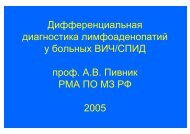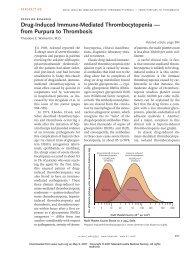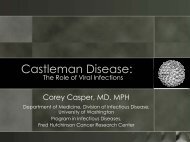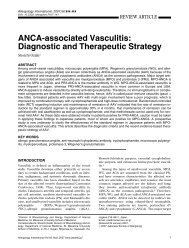Cladribine combined with cyclophosphamide and ... - Hem-aids.ru
Cladribine combined with cyclophosphamide and ... - Hem-aids.ru
Cladribine combined with cyclophosphamide and ... - Hem-aids.ru
Create successful ePaper yourself
Turn your PDF publications into a flip-book with our unique Google optimized e-Paper software.
Table 2<br />
CMC in untreated CLL<br />
T Robak et al<br />
Results of the treatment of B CLL patients <strong>with</strong> CMC accordingto the treatment protocol<br />
1513<br />
Rai All patients (%) CMC5 (%) CMC3 (%)<br />
stage n = 62 n = 20 n = 42<br />
n CR PR NR n CR PR NR n CR PR NR<br />
0 1 1 0 0 1 1 0 0 0 0 0 0<br />
(100.0) (100.0)<br />
I + II 28 10 11 7 9 3 2 4 19 7 9 3<br />
(35.7) (39.3) (26.0) (36.7) (22.2) (44.4) (36.8) (47.4) (15.8)<br />
III + IV 33 7 11 15 10 2 3 5 23 5 8 10<br />
(21.2) (33.3) (45.5) (20.0) (30.0) (50.0) (21.7) (34.8) (43.5)<br />
P value a 0.8 0.4 0.4<br />
Total 62 18 22 22 20 6 5 9 42 12 17 13<br />
(29.0) (35.5) (35.5) (30.0) (25.0) (45.0) (28.6) (40.4) (31.0)<br />
a<br />
P values for responses in different Rai stages.<br />
Table 3<br />
Severe hematological toxicity of the CMC programme<br />
Protocol Neutropenia Thrombocytopenia Anemia<br />
grade III <strong>and</strong> IV grade III <strong>and</strong> IV grade III <strong>and</strong> IV<br />
n (%) n1 (%) n (%) n1 (%) n (%) n1 (%)<br />
CMC5 7 (35.0) 9 (10.7) 4 (20.0) 6 (7.1) 2 (10.0) 4 (4.8)<br />
n = 20<br />
n1 = 84<br />
CMC3 11 (26.2) 21 (13.7) 8 (19.0) 14 (9.2) 2 (4.8) 2 (1.3)<br />
n = 42<br />
n1 = 153<br />
P value for 0.8 0.9 0.7 0.8 0.8 0.2<br />
CMC5 vs CMC3<br />
Total 18 (29.0) 30 (10.3) 12 (19.4) 20 (8.4) 4 (6.5) 6 (2.5)<br />
n = 62<br />
n1 = 237<br />
n, number of patients; n1, number of courses.<br />
<strong>with</strong> CMC5 <strong>and</strong> 11 treated <strong>with</strong> CMC3. Herpes zoster reactivation<br />
<strong>and</strong> herpes simplex infections were observed in 10<br />
patients (two after CMC5 <strong>and</strong> eight after CMC3). Tuberculosis<br />
was diagnosed in one patient after two courses of CMC5.<br />
Other opportunistic infections were not seen.<br />
In four patients, grade III vomiting according to the WHO<br />
classification was observed <strong>and</strong> in one DIC syndrome<br />
developed. Other non-hematological side-effects including<br />
alopecia, abnormal aminotransferases, transient increased<br />
LDH <strong>and</strong> creatinine levels were observed only very rarely<br />
(Table 4). Secondary cancers were observed in two patients<br />
includingone case of pulmonary cancer (adenocarcinoma)<br />
after CMC3 in a patient <strong>with</strong>out the history of tobacco<br />
exposure <strong>and</strong> one case of malignant histiocytosis after CMC5.<br />
Richter syndrome has not been observed to date<br />
The intervals between CMC courses due to myelosuppression<br />
<strong>and</strong>/or infections were prolonged from 4 to 8 weeks in<br />
23 (37%) patients <strong>and</strong> after 38 (16%) courses, including10<br />
patients (18 courses) treated <strong>with</strong> CMC5 <strong>and</strong> 13 patients (20<br />
courses) treated <strong>with</strong> CMC3. In four patients (two treated <strong>with</strong><br />
CMC5 <strong>and</strong> two <strong>with</strong> CMC3), therapy was stopped before the<br />
completion of three courses of treatment because of<br />
prolonged severe myelosuppression.<br />
Altogether, 14 (22.6%) patients died during the study,<br />
includingsix (30%) treated <strong>with</strong> CMC5 <strong>and</strong> eight (19.0%) <strong>with</strong><br />
CMC3. All six patients in the CMC5 group died before completingthree<br />
courses of treatment. In CMC3 group six out of<br />
eight patients died before completing three courses of treatment.<br />
The causes of death are shown in Table 5. Complications<br />
due to infections were the cause of death in nine<br />
patients, includingfour treated <strong>with</strong> CMC5 <strong>and</strong> five after<br />
CMC3 therapy.<br />
Discussion<br />
In spite of intensive research <strong>and</strong> important progress in the<br />
last years, CLL still remains incurable. The results of the r<strong>and</strong>omized<br />
studies published so far indicate that both FAMP <strong>and</strong><br />
2-CdA, applied as first-line therapy, significantly increase the<br />
rate of complete remissions when compared to chlorambucil,<br />
which is still regarded as the gold st<strong>and</strong>ard in CLL treatment. 5,8<br />
However, neither study proved that the higher remission rate<br />
is translated into longer survival. That is why further research<br />
is justified, <strong>with</strong> the objective to increase the remission rate<br />
<strong>and</strong> quality, <strong>and</strong> in this way, to influence survival time. In the<br />
trials finished to date, alkylatingd<strong>ru</strong>gs <strong>and</strong> anthracyclines <strong>with</strong><br />
mitoxantrone were most often <strong>combined</strong> <strong>with</strong> either FAMP or<br />
<strong>with</strong> 2-CdA. 10–18,29,30<br />
Our study is the first, to our knowledge, in which previously<br />
Leukemia







